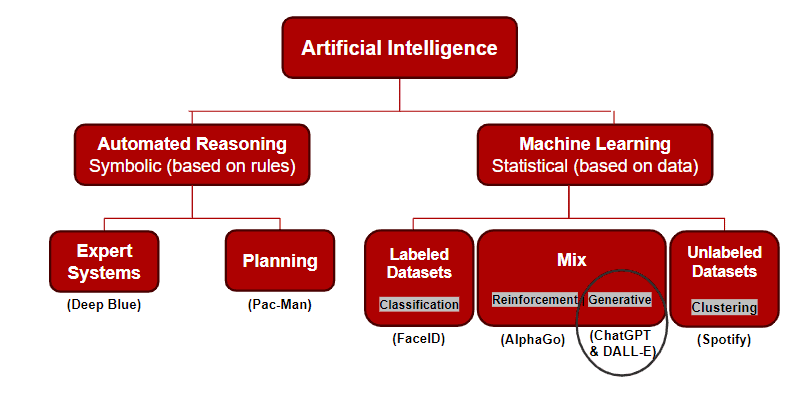
Here’s a quick overview of what is generative AI and how it can help you as a leader.
What is AI?
To start, let’s address a fundamental question: What exactly is AI?
In the simplest terms, AI is a system that replicates human abilities. As Allie Miller, a prominent figure in the AI field, puts it: “AI is a system doing a human thing.” This means AI can see, hear, write, make suggestions, and take decisions, just like us.
So then what’s Generative AI?
Here’s a chart that helps explain this, adapted from the Aspen Institute.

The Two Main Branches of AI
AI can be broadly categorized into two branches:
1. Automated Reasoning
Automated reasoning is symbolic and rule-based. Think of it as teaching a computer to be a detective or a puzzle solver. This branch further divides into two sub-branches:
- Expert Systems: These systems emulate the decision-making ability of human experts. IBM’s chess-playing computer, Deep Blue, is a prime example.
- Planning: This involves creating a sequence of actions to achieve a specific goal, like the strategy used by ghosts in the game Pac-Man to chase the player.
2. Machine Learning (ML)
Machine learning is statistical and data-driven, akin to teaching a computer to learn from experience. It’s important to note that ML is a subset of AI, not a separate discipline. Most of today’s AI advancements are in this area. Machine learning itself has several sub-branches:
- Labeled Datasets (Classification): Here, AI is trained with data already tagged with the correct answer. An example is the Face ID technology in smartphones.
- Unlabeled Datasets (Clustering): In this case, AI learns to organize data into groups based on similarities without preexisting labels, like Spotify’s recommendation system.
- Mixed Datasets: A blend of labeled and unlabeled datasets, with two key branches:
- Reinforcement Learning: It’s about learning through trial and error, as seen in AlphaGo, the board game-playing AI.
- Generative AI: This is where AI generates new, original content (more below).
Generative AI: The New Frontier
Generative AI stands out as it doesn’t just classify or predict; it creates. Let’s break down this branch of AI:
Understanding Generative AI
Generative AI uses both labeled and unlabeled datasets to generate new outputs that resemble the training data. It’s like someone who studies various forms of data and then creates something unique based on that data.
Key Examples of Generative AI
- ChatGPT: Trained on extensive text data, ChatGPT generates human-like text based on the input it receives.
- DALL-E: This AI creates images from text descriptions, learning from a vast dataset of images and their descriptions.
Generative AI is akin to an artist: learning from existing works and then producing unique creations. Generative AI is a part of machine learning, which in turn is a branch of AI.
If you’d like to learn more, check out my “Generative AI for Business Leaders” course on Udemy or my “Generative AI for Busy Business Leaders” book on Amazon.
